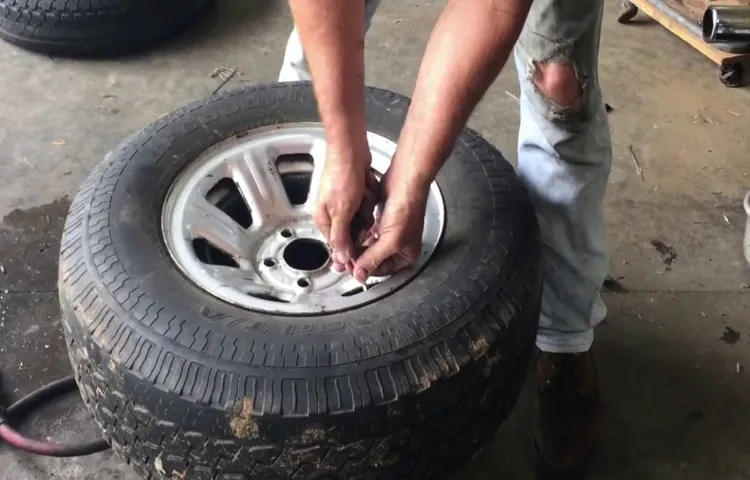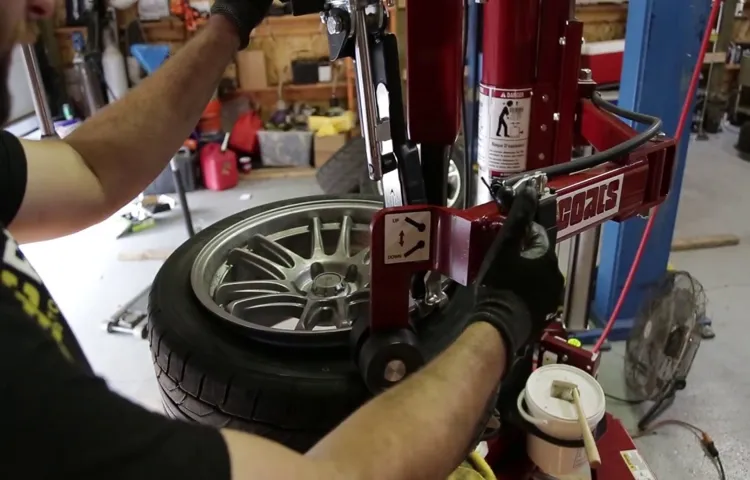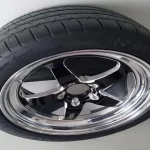Changing a tire is an essential skill that every driver should know. However, before you replace the old tire with a new one, you need to dismount the damaged one. Dismounting a tire may seem daunting at first, but with the right technique and tools, you’ll be able to do it with ease.
In this guide, we’ll show you how to dismount a tire step-by-step, so you can do it confidently and independently. Have you ever experienced a flat tire and didn’t know how to change it? Don’t worry; you’re not alone. Knowing how to dismount a tire is an essential skill for any driver to learn.
It not only saves you time and money but also ensures that you’re ready for any emergency on the road. The process of dismounting a tire involves removing it from the wheel rim, an integral part of the tire installation process. While it may seem complicated, dismounting a tire doesn’t have to be a daunting task.
With the proper equipment and knowledge, you can easily remove a tire from its rim, saving you a trip to the auto mechanic. In this guide, we’ll go through the steps you need to follow to dismount a tire. From loosening the lug nuts to using a tire machine to detach the tire from the rim, we’ll cover everything you need to know to dismount a tire like a pro.
So, grab your tools and let’s get started!
Table of Contents
Tools You Will Need
If you’re looking to dismount a tire, there are a few tools you’ll need to make the process go smoothly. The first tool you’ll need is a tire iron or a tire spoon. This tool will help you pry the tire off the rim of the wheel.
Along with the tire iron, you’ll also need a bead breaker. The bead breaker is a tool that breaks the seal between the tire and the rim, which helps when prying off the tire. Another important tool is a valve stem remover.
This tool allows you to remove the valve stem so that air can flow out of the tire. Lastly, you’ll need a tire machine or a set of tire changing stands to hold the tire. With all these tools in hand, you’ll be able to dismount the tire with ease.
Remember to be cautious and take your time when dismounting the tire, as it can be a delicate process to ensure that the tire doesn’t get damaged or punctured.
Tire Spoon
When it comes to changing a tire, having the right tools can make all the difference. One essential tool you will need is a tire spoon. A tire spoon is a tool used to remove and install tires from rims.
It is a long, curved lever that allows you to pry the tire away from the rim without damaging either. Using a tire spoon makes changing a tire much easier and faster, especially if you need to do it in a hurry or in unfavorable conditions. In addition to the tire spoon, you will also need a lug wrench, a jack, and wheel chocks to keep your vehicle in place while you work.
Having these tools on hand can help you feel confident and prepared in case of a flat tire emergency. So, the next time you hit the road, make sure you have all the necessary tools to keep your journey safe and stress-free.

Valve Core Remover
As a DIY bicycle enthusiast, you know that having the right tools is essential to keep your ride in top shape. One of the most important tools you need is a valve core remover. This tool helps you remove the valve core from your bike’s inner tube so you can easily replace or patch it.
Without a valve core remover, you may damage the valve stem or even the inner tube when trying to extract the core. Valve core removers come in different sizes and types, so you need to choose the right one that fits your valve stem. Some valve core removers are also multi-functional and can be used for other tasks like tightening or loosening the valve cap.
With the proper valve core remover, you can keep your bike’s tires well-maintained and avoid unnecessary trips to the bike shop.
Tire Lubricant
One of the essential tools you will need when applying tire lubricant is a clean cloth. This is because you need to ensure that the surface of your tire is clean and free from dirt or debris before you apply the lubricant. Additionally, a tire brush can also come in handy when cleaning the surface of your tire.
The brush helps to loosen and remove dirt or debris, ensuring that your tire is clean and ready for lubrication. Another tool you need is the tire lubricant itself, which is specially designed to reduce friction and help prevent tire wear and tear. When applying the lubricant, be sure to follow the instructions provided carefully, as the application process can vary depending on the brand of lubricant you are using.
By using the right tools and techniques, you can help prolong the life of your tires and ensure that they function effectively for longer.
Tire Bead Breaker
When it comes to changing tires on your car, one of the essential tools you will need is a bead breaker. This tool is specifically designed to break the bead of the tire from the rim, allowing you to remove the tire more easily. Using a bead breaker can save you a lot of time and effort, especially when dealing with stubborn tires that refuse to come off.
While there are different types of bead breakers available in the market, most of them consist of a handle and a curved blade or clamp that grips the tire and applies pressure to break the bead. Some also come with additional features such as adjustable clamps or multiple blades to accommodate different tire sizes. Regardless of the type of bead breaker you choose, make sure to follow the manufacturer’s instructions carefully and wear safety gear such as gloves and goggles to prevent injury.
By using a bead breaker, you can make the tire-changing process much smoother and efficient.
Steps to Dismount a Tire
Dismantling a tire may seem like a daunting task, but with some basic knowledge and a few tools, it can be done with ease. Before commencing the process, ensure that you have all necessary tools and protective gear, such as work gloves and eye protection. Begin dismounting by deflating the tire entirely, ensuring that all air is released.
Once this is done, pry the tire off the rim bead using tire irons or a tire changing machine. Insert the tire irons under the lip of the tire’s bead, and using a twisting motion, remove it from the rim bead. Repeat the process on both sides of the tire until it is entirely free from the rim.
Be careful during the process not to damage the tube or cause injury to yourself as the tire may still contain some pressure. In conclusion, knowing how to dismount a tire can save you a lot of money and hassle in the long run. So next time you need to remove a tire, remember these easy steps, and you’ll be a pro in no time!
Step 1: Remove the Valve Core
Dismounting a tire can seem like a daunting task, but with the right tools and steps, it can be a breeze. The first step in dismounting a tire is removing the valve core. This small piece is located in the center of the valve stem and is responsible for allowing air in and out of the tire.
To remove the valve core, you will need a valve core removal tool. Simply place the tool over the valve core and unscrew it in a counterclockwise direction. The valve core should easily pop out, allowing you to release the air from the tire.
Be sure to keep the valve core in a safe place, as you will need to replace it when you re-inflate the tire. Removing the valve core is an important first step in the dismounting process, as it will make releasing air from the tire much easier and give you better access to the tire itself. Make sure to take your time and be careful not to damage the valve stem as you remove the valve core.
Step 2: Break the Bead
Breaking the bead on a tire is an essential step in dismounting it from the rim. To do this, you will need a bead breaker tool or a sturdy lever. Start by positioning the tire so that the rim is facing up and the bead you want to break is facing down.
Secure the tire in place, and then use your tool to press down on the sidewall of the tire at the location of the bead. Apply steady pressure until you hear a popping sound, which indicates the bead has detached from the rim. Repeat this process at several points around the tire until both beads are free.
Be sure to take extra care when breaking the bead on high-performance or low-profile tires, which require greater force to loosen. Remember to protect yourself as well by wearing protective eyewear and gloves and taking your time to ensure a safe and thorough job.
Step 3: Remove the Tire from the Rim
The third step to dismounting a tire is to remove the tire from the rim. This step requires some physical strength, particularly if the tire is stiff, so brace yourself. Begin by pushing the tire bead on one side into the center of the rim.
Use tire spoons to pry the other side up and over the rim’s edge, starting at the spoke, working your way around the rim pulling the tire bead. Once you’ve removed the first side, slide the spoon over to the other side and repeat the process. Once the tire is removed from the rim, inspect both the tire and rim for any damage that may need to be repaired or replaced.
Removing the tire from the rim can be challenging, so take your time and don’t rush.
Step 4: Use the Tire Spoon to Remove the Tire Completely
Now that you’ve loosened the tire from the rim with the Tire Iron, it’s time to remove the tire completely. This is where the Tire Spoon comes into play. Using the hooked end of the spoon, carefully wedge it between the tire and the rim.
Work around the circumference of the tire, prying it away from the rim as you go. Be cautious not to scratch or damage the rim in the process. Once you’ve fully wedged the spoon in, you can use it to lift the tire up and over the rim.
This may take a little bit of effort, but with the right technique, you’ll be able to remove the tire completely. With the tire off, you can now inspect the tire for any damage or wear and tear before proceeding with the rest of your repair or replacement process. Don’t forget to repeat these steps on the other side of the tire to fully dismount it from your vehicle.
With a little bit of patience and finesse, you’ll have the tire off in no time using these tried and true tips.
Tips and Precautions
When it comes to changing a tire, knowing how to dismount it is a crucial part of the process. Firstly, you need to make sure that the tire is completely deflated before starting. This is important as it makes it easier to separate the tire from the wheel.
Using a tire lever, wedge the tool between the edge of the tire and the rim before prying it upwards gently. Move along the tire and repeat this process, being careful not to damage the wheel itself. If you’re having trouble, you can use a spray bottle filled with soapy water around the edges of the tire to make it easier to pry off.
Once you’ve dismounted the tire, you can then proceed to changing it. Remember to never rush this process and make sure you’re taking all the necessary precautions to prevent any potential injuries. By following these simple tips, dismounting your tire quickly and safely can be easily achieved!
Tip 1: Work on a Clean and Flat Surface
When it comes to working on any DIY project, having a clean and flat surface is one of the most important aspects to keep in mind. Not only will it make the project easier, but it will also help to ensure the end result looks polished and professional. Before starting any work, make sure to clear away any clutter and debris from the work area.
Wipe down the surface with a damp cloth to remove any dirt or dust that may have accumulated. A flat surface is also crucial, especially when working with precision tools or measurements. This will help prevent any mistakes that could cost you time and money.
If the surface you’re working on isn’t flat, consider using clamps or blocks to level it out. Additionally, be sure to check the surface regularly throughout the project to ensure it remains flat. By working on a clean and flat surface, you’ll set yourself up for success and have better results in your DIY projects.
Your workspace will not only be more efficient, it will also be safer and cleaner, making the entire project an enjoyable experience. Remember to clean up after yourself as you go, and you’ll be able to work on future projects with ease.
Tip 2: Wear Protective Gear
One of the most important tips for ensuring your safety while engaging in any outdoor activity is to wear protective gear. Whether you’re hiking, biking, or simply taking a stroll through the woods, protective gear can go a long way in preventing injuries. Many outdoor activities involve potential risks such as falls, insect bites, and exposure to UV rays, so it’s crucial to wear proper gear to minimize the risk of harm.
This can include items such as helmets, knee and elbow pads, insect repellent, and sunscreen. By taking the time to properly gear up before you head outdoors, you can enjoy your activity with peace of mind and minimize the risk of any potential injuries. So remember, safety first, and always wear the appropriate protective gear for your outdoor adventures.
Precaution 1: Do Not Rush
“Taking your time is crucial when dealing with any important decision, especially when it comes to financial matters. One of the most important precautions you can take is to not rush into anything. Impulsive decisions might feel good in the moment, but they can potentially lead to disastrous outcomes down the line.
It’s important to research and analyze your options thoroughly, so you can make an informed decision that takes into account all the necessary factors. Take the time to read the fine print, evaluate any risks involved, and weigh the pros and cons before deciding the best course of action. By taking careful and considered steps, you’ll be much more likely to achieve your goals and avoid any pitfalls that might come your way.
“
Precaution 2: Be Careful With the Tire Spoon
When changing a tire or fixing a punctured one, using a tire spoon will make the task much easier. However, it is important to take precautions when using one. First and foremost, ensure that the spoon is of good quality and sturdy enough to handle the task.
Additionally, use it carefully to avoid damaging the tire or rim. Applying too much force can cause damage to the tire, while slip-ups may scratch or dent the rim. It is also important to use the spoon in the right position and angle to avoid causing any accidental harm.
Using a tire spoon requires concentration and confidence, so take your time and don’t rush the task. Remember to wear protective gear, including gloves and goggles, to avoid any possible injuries. By following these tips, you can safely use a tire spoon to keep your tires running smoothly.
Conclusion
In short, removing a tire requires some elbow grease and a bit of finesse. But fear not, with the right tools and approach, you can avoid any unnecessary mishaps and get back on the road in no time. So, go ahead and give it a try! And remember, if all else fails, there’s no shame in calling in the professionals.
“
FAQs
1. What tools are needed to dismount a tire?
A tire iron, bead breaker, and tire changer are all necessary tools to properly dismount a tire.
2. Can a tire be dismounted without a tire changer?
It is possible to dismount a tire without a tire changer, but it requires more manual effort and can be more difficult.
3. What is the process for using a tire changer to dismount a tire?
First, loosen the lug nuts and remove the wheel from the vehicle. Then, use the bead breaker to break the seal between the tire and wheel. Finally, use the tire changer to loosen the tire from the wheel and remove it.
4. Is dismounting a tire a DIY job or should it be done by a professional?
It is possible to dismount a tire on your own, but if you are not experienced with tire changing, it is recommended to have the job done by a professional to ensure safety and prevent damage to the rims or tire.
5. How often should tires be dismounted for maintenance?
There is no set schedule for when tires should be dismounted for maintenance, but it’s recommended to have them dismounted when you notice uneven wear, a loss of air pressure, or if it’s time for a tire rotation.
6. What are the dangers of improperly dismounting a tire?
Improper dismounting of a tire can cause injury to the person performing the task, damage to the vehicle, and harm to the tire itself. It’s important to follow proper safety procedures and use the correct tools for the job.
7. Are there any tips for making the tire dismounting process easier?
Lubricating the tire and wheel can make the dismounting process easier, as well as using the correct tools and having a helper to hold the wheel steady while you work.



